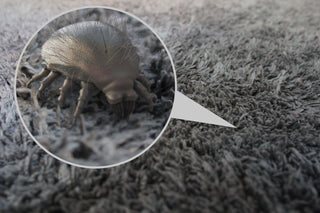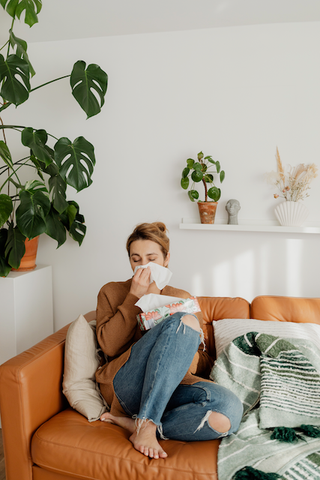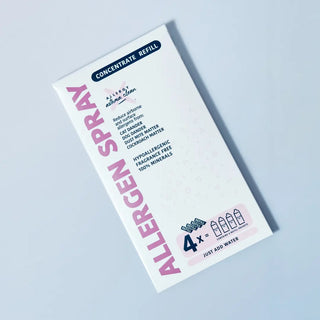

Allergens
Allergic to Dust Mites?
Here's an Essential Guide on How to Get Rid of Them
Dust mites are microscopic pests that thrive in bedding, carpets, and upholstery, feeding on dead skin cells and leaving behind potent allergens. These invisible intruders are one of the most common triggers of year-round allergies and asthma, causing sneezing, congestion, itchy eyes, and poor indoor air quality. Reducing dust mites through regular cleaning, hot water washing, and dehumidifying your home can make a major difference. For added protection, a lab-verified dust mite spray, such as Allergy Asthma Clean Allergen Spray by Allergy Defender, helps neutralize up to 99% of surface allergens and 95% of airborne particles—supporting a cleaner, healthier home naturally.
Key Takeaways
- Dust mites are one of the leading causes of indoor allergies, thriving in warm, humid environments like bedding, carpets, and upholstered furniture.
- Regular cleaning—vacuuming with a HEPA filter, washing bedding in hot water, and maintaining low humidity—can reduce dust mite populations.
- Allergy Asthma Clean Allergen Spray by Allergy Defender offers a effective, mineral-based solution to reduce dust mite allergens without harsh chemicals.
- Hard flooring, dust-resistant furniture, and proper air filtration (HEPA or MERV 10+) can further improve indoor air quality.
- Combining a natural dust mite spray with smart cleaning habits supports long-term natural allergy relief and a healthier living space.
Dust Mites
Dust mites: the invisible intruders lurking in the corners of your home and wreaking havoc on your health. These microscopic creatures live in carpets, bedding, and upholstery, feeding on dead skin cells and leaving behind a trail of allergens that can trigger respiratory issues and other allergic reactions. But fear not! In this article, we'll explore effective strategies to keep your space clean and allergy-free.
From regular vacuuming and dusting to using allergen-proof covers and washing linens in hot water, we'll uncover the most efficient ways to banish dust mites from your home. We'll also delve into the importance of maintaining proper humidity levels, as these critters thrive in moist environments. By implementing these practical tips and lifestyle changes, you can create a healthier environment for yourself and your family.
Don't let these uninvited guests take over your space. Take charge of your home's cleanliness and kick those dust mites to the curb. Join us as we reveal the hidden menace in your home and arm you with the knowledge to keep your living space fresh, clean, and allergy-free.

What are dust mites?
Dust mites are small, spider-like creatures that live in soft surfaces. They are too small to be seen with the naked eye. They thrive in warm, humid environments. Dust mites live in mattresses, bedding, upholstered furniture, and carpets. Since they like warm, moist spots, it's no wonder Antarctica is the only place they don't exist! Their food source is the dead skin cells that people and animals shed. In addition, the feces and body parts of dust mites contain a potent allergen that can cause problems for people who are sensitive to it. Dust mite allergies are among the most common types of allergies, affecting millions worldwide. In addition, they are the most common cause of year-round allergies and asthma.
Dust mite allergies are among the most common types of allergies, affecting millions worldwide. In addition, they are the most common cause of year-round allergies and asthma

A variety of symptoms
Dust mite allergies can manifest in various ways, and it's important to be able to recognize the signs and symptoms. The most common symptoms of dust mite allergies include frequent sneezing, runny or stuffy nose, itchy or watery eyes, and coughing. Some individuals may also experience wheezing, chest tightness, or shortness of breath, especially if they have underlying respiratory conditions like asthma. These symptoms may worsen when spending time in areas with a high concentration of dust mites, such as bedrooms or living rooms. It's essential to pay attention to any changes in your health or the health of your family members, as prolonged exposure to dust mites can lead to chronic respiratory issues and decreased quality of life. To confirm if dust mites are the cause of your allergies, consult with a healthcare professional who can perform allergy tests. Once you're certain about the triggers, it's time to implement effective cleaning methods and lifestyle changes to minimize the presence of dust mites in your home.


What about furniture?
One of the most critical considerations for dust mite allergy sufferers is the type of furniture they have in their homes. Upholstered furniture and carpets are ideal breeding grounds for dust mites, so choosing easy-to-clean and dust-resistant furniture is essential. Leather, vinyl, and plastic are excellent choices, as they can be wiped down with a damp cloth and don't harbor dust mites as quickly as other materials. Avoid deep pile carpets and rugs, as they are challenging to clean and can trap dust and allergens. Opt for hardwood floors or low-pile area rugs instead. By making thoughtful choices about the furniture in your home, you can help reduce your exposure to dust mites and other allergens.


Dust Mite Allergy Treatment (The last one is backed by science)
Bedding & mattresses: Our most significant exposure to dust mites will occur in bed since we spend at least eight hours there. So, use a dust mite cover on your mattress and pillows. These covers are designed to create a sterile environment for dust mites and can effectively reduce their population. Another option is to use dust mite-proof sheets when you sleep. These sheets are usually made of silk or polyester and can create a barrier that dust mites cannot penetrate.
Vacuuming: Effectively removes dust mites from your mattress, but it's essential to do it regularly. For best results, vacuum your mattress at least once a week using a vacuum with a HEPA filter. The ideal time is when you're washing your bedding. Keep the dust mite cover on (see Laundry below for instructions for washing covers).
Dust: Dust weekly with a damp cloth or dust mop.
Humidity levels: Since dust mites thrive in humid environments, keeping the level in your home low can help reduce their population. One way to reduce the humidity in your home is to use a dehumidifier, which can be placed in any room and will reduce the amount of moisture in the air.
Air conditioners also effectively reduce humidity levels in your home; here's how they work. First, air conditioners draw air from your home and pass it over a refrigerant coil. Next, this coil is cooled by a Freon gas, which also causes the air to cool. The cooled air is then blown back into your home. At the same time, the air conditioner also removes moisture from the air. This moisture collects on the evaporator coil, where it is emptied outside your home.
Also, turn on ventilation fans in your kitchen when cooking, your bathroom when bathing, and your laundry room when washing clothes.
By taking these measures, you can reduce the amount of moisture in the air and create a more comfortable environment for you, but not for dust mites.
Laundry: Wash bedding in hot water (at least 130 degrees Fahrenheit) once a week. A dust mite's life cycle is only about two months long, but in that time, a female can lay up to 80 eggs, so hot water and frequent washings are wise ideas.
Carpeting, upholstery: Run your vacuum several times a week. And on upholstered furniture at least once a week. You can try using a HEPA filter in your vacuum cleaner. A HEPA filter will help trap dust mites and other allergens, making it easier to keep your home free of them.
Children's toys: A favorite stuffed pet might be hard to get rid of if your child has a dust mite allergy. Wash the stuffed animal in hot water (130 degrees) weekly. If that's not possible, put the stuffed "lovey" in the freezer overnight. This should kill the dust mites.
Hard flooring: Weekly damp mop hard surface floors. Be sure to wipe the corners where dust collects.
Other ideas: Install a HEPA (High-Efficiency Particulate Air) purifier in your bedroom and in other rooms in your home that you tend to frequent.
Change your HVAC (Heating, Ventilation Air Conditioning) filter regularly. Choose a MERV filter (Minimum Efficiency Reporting Values) rated to help clean your home's air.
Remove carpeting and upholstered furniture in your home if possible.
Remove curtains in your bedroom.
For a more natural approach, Allergy Spray, a mineral-based spray, provides immediate control from airborne and surface allergens, including dust mites. This lab-verified solution is designed to protect you effectively and safely from dust mites.
Defend Your Health
Articles

Choosing the Right Nasal Spray for Your Needs
Many nasal sprays—especially decongestant sprays like oxymetazoline (Afrin) or phenylephrine—are only meant to be used for 3 consecutive days. Why

Natural Alternatives to Prednisone for Allergies
If you’re among the millions dealing with chronic inflammatory conditions like allergic rhinitis, seasonal allergies, or atopic dermatitis, you’re likely wondering whether natural alternatives can provide relief without the concerning...







